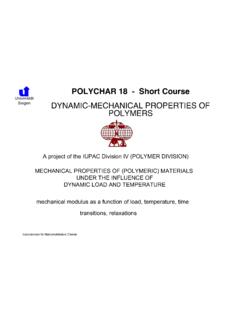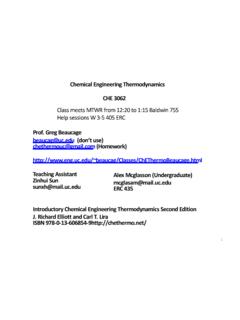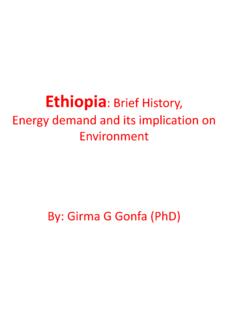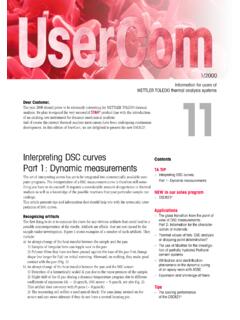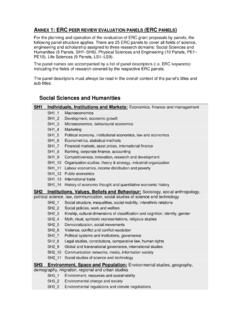Transcription of Properties of Gases and Liquids - University of Cincinnati
1 THEPROPERTIESOFGASESANDLIQUIDSB ruce E. PolingProfessor of Chemical EngineeringUniversity of ToledoJohn M. PrausnitzProfessor of Chemical EngineeringUniversity of California at BerkeleyJohn P. O ConnellProfessor of Chemical EngineeringUniversity of VirginiaFifth EditionMcGRAW-HILLNew York Chicago San Francisco Lisbon LondonMadrid Mexico City Milan New Delhi San JuanSeoul Singapore Sydney TorontoCopyright 2001, 1987, 1977, 1966, 1958 by The McGraw-Hill Companies, Inc. All rights in the United States of America. Except as permitted under the United States CopyrightAct of 1976, no part of this publication may be reproduced or distributed in any form or by any means,or stored in a database or retrieval system, without the prior written permission of the publisher. 0-07-149999-7 The material in this eBook also appears in the print version of this title: trademarks are trademarks of their respective owners. Rather than put a trademark symbol afterevery occurrence of a trademarked name, we use names in an editorial fashion only, and to the bene-fit of the trademark owner, with no intention of infringement of the trademark.
2 Where such designa-tions appear in this book, they have been printed with initial caps. McGraw-Hill eBooks are available at special quantity discounts to use as premiums and sales promo-tions, or for use in corporate training programs. For more information, please contact George Hoare,Special Sales, at or (212) 904-4069. TERMS OF USE This is a copyrighted work and The McGraw-Hill Companies, Inc. ( McGraw-Hill ) and its licensorsreserve all rights in and to the work. Use of this work is subject to these terms. Except as permittedunder the Copyright Act of 1976 and the right to store and retrieve one copy of the work, you may notdecompile, disassemble, reverse engineer, reproduce, modify, create derivative works based upon,transmit, distribute, disseminate, sell, publish or sublicense the work or any part of it withoutMcGraw-Hill s prior consent. You may use the work for your own noncommercial and personal use;any other use of the work is strictly prohibited.
3 Your right to use the work may be terminated if youfail to comply with these terms. THE WORK IS PROVIDED AS IS. McGRAW-HILL AND ITS LICENSORS MAKE NO GUAR-ANTEES OR WARRANTIES AS TO THE ACCURACY, ADEQUACY OR COMPLETENESS OFOR RESULTS TO BE OBTAINED FROM USING THE WORK, INCLUDING ANY INFORMA-TION THAT CAN BE ACCESSED THROUGH THE WORK VIA HYPERLINK OR OTHERWISE,AND EXPRESSLY DISCLAIM ANY WARRANTY, EXPRESS OR IMPLIED, INCLUDING BUTNOT LIMITED TO IMPLIED WARRANTIES OF MERCHANTABILITY OR FITNESS FOR APARTICULAR PURPOSE. McGraw-Hill and its licensors do not warrant or guarantee that the func-tions contained in the work will meet your requirements or that its operation will be uninterrupted orerror free. Neither McGraw-Hill nor its licensors shall be liable to you or anyone else for any inaccu-racy, error or omission, regardless of cause, in the work or for any damages resulting has no responsibility for the content of any information accessed through the no circumstances shall McGraw-Hill and/or its licensors be liable for any indirect, incidental,special, punitive, consequential or similar damages that result from the use of or inability to use thework, even if any of them has been advised of the possibility of such damages.
4 This limitation of lia-bility shall apply to any claim or cause whatsoever whether such claim or cause arises in contract, tortor otherwise. DOI: hope you enjoy thisMcGraw-Hill eBook! Ifyou d like more information about this book,its author, or related books and websites,please click to learn more?iiiCONTENTSP reface viiChapter 1 The Estimation of Physical Introduction Estimation of Properties Types of Estimation Organization of the Book 2 Pure Component Scope Vapor-Liquid Critical Properties Acentric Factor Boiling and Freezing Points Discussion of Estimation Methods for Pure Component Constants Dipole Moments Availability of Data and Computer Software 3 Thermodynamic Properties of Ideal Scope and Definitions Estimation Methods Method of Joback Method of Constantinou and Gani (CG) Method of Benson [1968; 1969] Discussion and Recommendations Heat of Combustion 4 Pressure-Volume-Temperature Relationships of PureGases and Scope Introduction to Volumetric Properties Corresponding States Principle Equations of State Virial Equation of State Analytical Equations of State Nonanalytic Equations of State Discussion of Equations of State PVT Properties of Liquids General Considerations more information about this title, click hereivCONTENTS4-10 Estimation of the Liquid Molar Volume at the Normal Boiling Point Saturated Liquid Densities as a Function of Temperature Compressed Liquid Densities 5 Pressure-Volume-Temperature Relationships of Mixtures Scope Mixture Properties General Discussion Corresponding States Principle (CSP).
5 The Pseudocritical Method Virial Equations of State for Mixtures Analytical Equations of State for Mixtures Nonanalytic Equations of State for Mixtures Discussion of Mixture Equations of State Densities of Liquid Mixtures at Their Bubble Point Densities of Compressed Liquid Mixtures 6 Thermodynamic Properties of Pure Componentsand Scope Fundamental Thermodynamic Relationships for Pure Components Departure Functions for Thermodynamic Properties Evaluation of Departure Functions for Equations of State Heat Capacities of Real Gases Heat Capacities of Liquids Partial Properties and Fugacities of Components in Mixtures True Critical Points of Mixtures 7 Vapor Pressures and Enthalpies of Vaporization ofPure Scope Theory Correlation and Extrapolation of Vapor-Pressure Data Ambrose-Walton Corresponding-States Method Riedel Corresponding-States Method Discussion and Recommendations for Vapor-Pressure Estimation andCorrelation Enthalpy of Vaporization of Pure Compounds Estimation of Hvfrom Vapor-Pressure Equations Estimation of Hvfrom the Law of Corresponding States Hvat the Normal Boiling Point Variation of Hvwith Temperature Discussion and Recommendations for Enthalpy of Vaporization Enthalpy of Fusion Enthalpy of Sublimation; Vapor Pressures of Solids 8 Fluid Phase Equilibria in Multicomponent Scope Thermodynamics of Vapor-Liquid Equilibria Fugacity of a Pure Liquid Simplifications in the Vapor-Liquid Equilibrium Relation Activity Coefficients.
6 Gibbs-Duham Equation and Excess Gibbs Energy Calculation of Low-Pressure Binary Vapor-Liquid Equilibria with ActivityCoefficients Effect of Temperature on Low-Pressure Vapor-Liquid Equilibria Binary Vapor-Liquid Equilibria: Low-Pressure Examples Multicomponent Vapor-Liquid Equilibria at Low Pressure Determination of Activity Coefficients Phase Equilibrium with Henry s Law Vapor-Liquid Equilibria with Equations of State Solubilities of Solids in High-Pressure Gases Liquid-Liquid Equilibria Phase Equilibria in Polymer Solutions Solubilities of Solids in Liquids Aqueous Solutions of Electrolytes Concluding Remarks 9 Scope Definitions of Units of Viscosity Theory of Gas transport Properties Estimation of Low-Pressure Gas Viscosity Viscosities of Gas Mixtures at Low Pressures Effect of Pressure on the Viscosity of Pure Gases Viscosity of Gas Mixtures at High Pressures Liquid Viscosity Effect of High Pressure on Liquid Viscosity Effect of Temperature on Liquid Viscosity Estimation of Low-Temperature Liquid Viscosity Estimation of Liquid Viscosity at High Temperatures Liquid
7 Mixture Viscosity 10 Thermal Scope Theory of Thermal Conductivity Thermal Conductivities of Polyatomic Gases Effect of Temperature on the Low-Pressure Thermal Conductivities of Gases Effect of Pressure on the Thermal Conductivities of Gases Thermal Conductivities of Low-Pressure Gas Mixtures Thermal Conductivities of Gas Mixtures at High Pressures Thermal Conductivities of Liquids Estimation of the Thermal Conductivities of Pure Liquids Effect of Temperature on the Thermal Conductivities of Liquids Effect of Pressure on the Thermal Conductivities of Liquids Thermal Conductivities of Liquid Mixtures 11 Diffusion Scope Basic Concepts and Definitions Diffusion Coefficients for Binary Gas Systems at Low Pressures: Prediction fromTheory Diffusion Coefficients for Binary Gas Systems at Low Pressures: EmpiricalCorrelations The Effect of Pressure on the Binary Diffusion Coefficients of Gases The Effect of Temperature on Diffusion in Gases Diffusion in Multicomponent Gas Mixtures Diffusion in Liquids .
8 Theory Estimation of Binary Liquid Diffusion Coefficients at Infinite Dilution Concentration Dependence of Binary Liquid Diffusion Coefficients The Effects of Temperature and Pressure on Diffusion in Liquids Diffusion in Multicomponent Liquid Mixtures Diffusion in Electrolyte Solutions 12 Surface Scope Introduction Estimation of Pure-Liquid Surface Tension Variation of Pure-Liquid Surface Tension with Temperature Surface Tensions of Mixtures A Property Data Bank B Lennard-Jones Potentials as Determined from Viscosity Data C Group Contributions for Multiproperty Methods follows Appendix CviiPREFACER eliable values of the Properties of materials are necessary for the design of in-dustrial processes. An enormous amount of data has been collected and correlatedover the years, but the rapid advance of technology into new fields seems alwaysto maintain a significant gap between demand and availability.
9 The engineer is stillrequired to rely primarily on common sense, experience, and a variety of methodsfor estimating physical book presents a critical review of various estimation procedures for a lim-ited number of Properties of Gases and Liquids : critical and other pure componentproperties;PVTand thermodynamic Properties of pure components and mixtures;vapor pressures and phase-change enthalpies; standard enthalpies of formation;standard Gibbs energies of formation; heat capacities; surface tensions; viscosities;thermal conductivities; diffusion coefficients; and phase equilibria. For most cases,estimated Properties are compared to experiment to indicate reliability. Most meth-ods are illustrated by procedures described are necessarily limited to those that appear to theauthors to have the greatest validity and practical use. Wherever possible, we haveincluded recommendations delineating the best methods for estimating each prop-erty and the most reliable techniques for extrapolating or interpolating the book is intended to serve primarily the practicing engineer, espe-cially the process or chemical engineer, other engineers and scientists concernedwith Gases and Liquids may find it first edition of this book was published in 1958, the second in 1966, thethird in 1977 and the fourth in 1987.
10 In a sense, each edition is a new book becausenumerous estimation methods are proposed each year; over a (roughly) 10-yearspan, many earlier methods are modified or displaced by more accurate or moregeneral techniques. While most estimation methods rely heavily on empiricism, thebetter ones those that are most reliable often have a theoretical basis. In somecases, the theory is outlined to provide the user with the foundation of the proposedestimation are some significant differences between the current edition and the pre-ceding 2 includes several extensive new group-contribution methods as wellas discussion and comparisons of methods based on descriptors calculated withquantum-mechanical methods. Direct comparisons are given for more than 200substances with data in Appendix 3 includes several new methods as well as updated Benson-Methodtables for ideal-gas Properties of formation and heat capacities. Direct com-parisons are given for more than 100 substances with data in Appendix 4 includes presentation of current equations of state for pure compo-nents with complete formulae for many models, especially cubics.

